Panang curry แกงแพนง is one of the most popular curries in Thailand and overseas alike. Growing up in Thailand, it's a curry we made at home a lot because of its simplicity and speed. There's very little prep involved (if you buy the curry paste), and the whole thing is done in minutes.
It's also gluten-free, and can be made vegan (more on this in the FAQ). This panang curry recipe is made with pork, which is the most popular protein in Thailand, but I also have a recipe for panang beef, or you can substitute chicken for this recipe as well.

What is Panang Curry?
Of all the different Thai coconut milk based curries, panang curry is one that is quite unique. Instead of having plenty of liquid like a Thai green curry or red curry, panang curry comes in a small amount of thick, rich sauce. You can make an argument that it's more of a saucy stir fry.
Another defining feature is the generous use of cumin and coriander seeds which distinguishes its flavour from the basic Thai red curry. Makrut lime leaves (aka kaffir lime leaves) are also considered must-have for panang curry. Peanuts are ground into the curry paste, making the resulting sauce thicker and richer, though for commercial panang curry pastes, the peanuts are often omitted or replaced with mung beans to avoid allergies.
You can buy panang curry pastes from some Asian grocery stores that stock a lot of Southeast Asian products, but it's not an easy one to find. So I have included how to make panang curry paste from scratch in this recipe, OR if you're short on time you can also try my shotcut - the semi-homemade panang curry paste - which includes just a few ingredients added to store bought red curry paste.
Ingredients and Notes
Here are all the ingredients you'll need and important notes about them. For amounts, see the full recipe card below.
- Panang curry paste, store bought or homemade (recipe below). This is the heart of the curry and the quality of your curry hangs on the quality of your paste. So if you're going to use store bought, make sure it is good quality. My preference is for Maeploy or Aroy D brands, and if you cannot find store bought panang curry paste, you can also buy red curry paste and add a few ingredients to it to turn it into a panang paste.
- Coconut milk. It's important to use good quality coconut milk when it comes to Thai curries, read more about how to choose good coconut milk here.
- Fish sauce. More about how to choose good fish sauce here.
- Sugar. If you have palm sugar, you can use it, but for this granulated white sugar or light brown sugar will also work just fine.
- Pork tenderloin or pork collar butt, sliced thinly (~⅛ inch) or you can substitute chicken breast or thigh, sliced about ½-inch thick.
- Makrut lime leaves, also known as kaffir lime leaves. This is an important flavour in panang curry. It adds a citrusy aroma the helps brighten and lighten the otherwise rich curry. If you can't find fresh, frozen is the second best option, and dried would be the last resort.
- Mild red chilies for garnish, optional. This is just to give it some colour. Traditionally we use spur chilies or prik chee fa, but any kind of red pepper will do.
Homemade Panang Curry Paste Ingredients
Again, you do NOT have to make it from scratch! It is perfectly acceptable to use store bought, and see my hack for making semi homemade panang curry paste below!
- Dried Chilies. Panang is not supposed to be a super spicy curry, so I stick with mild dried chilies such as guajillo or puya chilies. If you want to add some heat, you can add some spicier chilies such as Thai or arbol chilies as well.
- Coarse salt. If you're pounding by hand, the coarseness will help add some friction, but if making by machine, any kind of salt is fine.
- Cumin seeds, toasted
- Coriander seeds, toasted
- White peppercorns
- Chopped lemongrass, use lemongrass from the bottom half only which is where the flavour is most concentrated. More about lemongrass here.
- Chopped galangal. Fresh or frozen galangal will do. More about galangal here.
- Makrut lime zest. AKA kaffir lime zest. This is the green part of the skin of the makrut limes, and it is very hard to find so I wouldn't worry so much if you don't have it. It has the same aroma as makrut lime leaves, so you can always just add a few extra leaves into the curry. More about makrut lime leaves here.
- Cilantro roots. Simply the roots of the cilantro/coriander plant! This is a common ingredient in Thai cuisine, but outside of Thailand it can be hard to find. Not to worry, you can substitute cilantro stems instead!
- Garlic
- Shallots
- Shrimp paste, called gapi in Thai, this is a fermented shrimp paste, which is an ingredient added to most Thai curries. It is salty and has a funky smell but adds a huge amount of umami. If you don't have it, you can omit it, and you'll just need to add a little more fish sauce to the curry.
- Roasted peanuts. This adds richness to the curry, if you're allergic to peanuts you can substitute another nut or seeds that you are not allergic to to mimic the same richness.
Hack: Making a Quick Semi-Homemade Panang Curry Paste
Panang curry paste tends to be hard to find in stores, but red curry pastes are available everywhere. The good news is that the two share many, many ingredients because Thai red curry paste is essentially our "basic" paste upon which other pastes are built.
With this knowledge, we can take the widely available red curry paste and simply add a few extra ingredients that would turn it into panang. Here are the ingredients you'll need.
- Store bought red curry paste, I recommend Maeploy, Aroy D or Namjai brands. Blue Elephant is also good for those in the UK. Do NOT use Thai Kitchen as it is very weak.
- Toasted cumin seeds
- Toasted coriander seeds
- Roasted peanuts, if allergic, you can sub another type of nuts or seeds that you can eat.
- Fermented shrimp paste, this is optional, and if your red curry paste already contains shrimp paste you don't need to add anymore.
How to Make Panang Curry
Here's a bird's eye view of the process, the full instructions are in the recipe card below, and if it's your first time make sure you watch the video below to ensure success.

- Reduce some of the coconut milk in a wok or large skillet until very thick.
- Add the curry paste and stir to mix.
- Keep stirring until coconut oil starts to separate and sizzle around the curry paste.
- Add the palm sugar and torm makrut lime leaves and stir until the sugar is dissolved.

- Add the meat and toss to coat in the paste (image shows beef, but it would be the same if using pork or chicken).
- Add the remaining coconut milk and stir until the meat is cooked through, then turn off the heat.
- Taste and adjust seasoning with more fish sauce if needed, then stir in the red pepper.
- Plate and top with julienned makrut lime leaves for garnish.
Watch the Video Tutorial
Here's the video showing how to make panang curry with beef, though the process would be exactly the same if using pork or chicken. (I do have a video that shows how to make panang curry with pork, but I have since updated my process so this one is better 😊). If you enjoy my videos, please consider subscribing to my YouTube channel. Thank you!
Storing Leftover and Advance Prep
Panang curry keeps quite well and is great for meal prep. In the fridge it should last up to a week, just be sure not to overcook the meat when you reheat it. Any leftover curry paste can be frozen.
To make this dish even quicker to pull off on a weeknight, make your curry paste in advance, and you can keep curry paste frozen for several months. You can even make a large amount if you want to come back to this dish regularly!
Save this recipe!
FAQ
If you're making the curry paste from scratch, the first thing to do is omit the shrimp paste. If using store-bought curry pastes, check the ingredient list to see if it contains shrimp paste.
You can replace the meat with sliced and pan-fried tofu or your meat substitute of choice. Frozen-then-fried tofu is actually great for this. In my first cookbook, Hot Thai Kitchen, I also have a panang recipe with roasted portobello mushroom, grilled peppers, and roasted eggplant. The fish sauce can be simply replaced with soy sauce.
Simply cook your veg separately, make the curry sauce as per the recipe, then toss the two together.
The main difference between panang and most other Thai curries is that panang has a smaller amount of sauce that is thick and rich, whereas most other Thai curries have plenty of liquid that is quite soupy.
Panang also does not involve any vegetables, and uses only one herb, makrut lime leaves, in addition to what's in the curry paste. I have to say, though, that if you order panang curry in a N. American Thai restaurant, it might not be as I just described because I have seen many restaurants make it soupy, with added vegetables, but now you know that that is the "Westernized" way!
In terms of the curry paste itself, the ingredients are all of the usual suspects of Thai curries: lemongrass, galangal, dried chilies, etc., but roasted peanuts are added to thicken the sauce. In commercial pastes, sometimes beans are used instead to avoid allergies.
More Classic Thai Recipes You'll Love
If you're ready to try more dishes, here are some popular classic Thai recipes to check out, complete with video tutorials as always!
Recipe
Print
Authentic Thai Panang Curry
- Prep Time: 20 mins
- If making curry paste: 20 mins
- Cook Time: 5 mins
- Total Time: 45 minutes
- Yield: 2 servings
Description
Authentic recipe for Thai panang curry, just like you'd have it in Thailand! This recipe uses pork, which is the most common type of panang curry in Thailand, but you can substitute chicken if you wish. If you want to use beef, see my recipe for panang beef which gives some extra tips for making sure your beef is tender.
Ingredients
Save this recipe!
- 4 Tbsp (60 ml) panang curry paste, store bought use one of the recipes below (see note 1)
- 10.5 oz (300 g) pork tenderloin or collar but, thinly sliced against the grain (see note 2)
- 1½ tsp (7.5 ml) fish sauce
- 2 tsp (10 ml) neutral oil
- 1 ¼ cups (300 ml) coconut milk, plus a little extra for garnish if you wish
- 10 makrut lime leaves, 7 roughly torn into chucks, 3 finely julienned for garnish
- 1½ Tbsp (18 g) palm sugar, finely chopped, packed
- ⅛ red bell pepper, julienned for garnish, optional
- Jasmine rice for serving
Option 1: Homemade Panang Curry Paste
- 10 g dried mild chilies, such as guajillo or puya peppers.
- ½ tsp coarse salt
- ¾ tsp cumin seeds
- 1½ tsp coriander seeds
- ¼ tsp white peppercorns
- 3 Tbsp chopped lemongrass, from bottom half only
- 1 Tbsp chopped galangal
- 1 ½ tsp makrut lime zest (aka kaffir lime)
- 2 cilantro roots or 6 cilantro stems, chopped
- 3 Tbsp chopped garlic
- ¼ cup chopped shallots
- 1 tsp fermented shrimp paste (gapi)
- 2 Tbsp roasted peanuts (if allergic, sub another type of nuts or seeds)
Option 2: Semi-Homemade Panang Curry Paste
- 4 tablespoon red curry paste
- ¾ tsp cumin seeds
- 1 ½ tsp coriander seeds
- 2 Tbsp roasted peanuts (if allergic, sub another type of nuts or seeds)
- 1 tsp fermented shrimp paste (optional, only if the red curry paste doesn’t already have it)
Instructions
For the Curry:
- Add 1½ teaspoon fish sauce and oil to the pork and massage it in with your hands, separating the pieces that are stuck together as you mix.
- In a saute pan or a wok over medium high heat, reduce ¾ cup coconut milk until thickened and creamy. Stir in curry paste and reduce the heat to medium low. Cook the paste for a few minutes, stirring constantly, until coconut oil separates away from the paste. If the paste sticks to the pan, you can deglaze with a bit of the remaining coconut milk.
- Add palm sugar and torn makrut lime leaves and cook for a minute or so until the sugar is dissolved.
- Add the pork and quickly toss it with the curry paste, separating the pieces as much as you can. Once the pork is about 50% cooked, add the remaining coconut milk and stir for just one more minute, just until the pork is mostly cooked through, then turn off the heat. *Do not overcook the pork or it will become chewy; it will continue to cook in the residual heat even after you turn off the heat. If it looks too dry, you can add a splash of water at this point.
- Stir in red peppers, if using. Taste and adjust seasoning with more fish sauce as needed. The amount of fish sauce you need greatly depends on how salty your curry paste is, which varies between brands.
- Plate, and if you have extra coconut milk handy, it's traditional to garnish panang curry with a little drizzle of coconut milk on top, but don't worry if you don't have any extra. Top with julienned makrut lime leaves and more red peppers as desired.
- Serve with jasmine rice, enjoy!
For the Homemade Panang Curry Paste:
*This method requires the use of a large granite mortar and pestle. You can also use an immersion blender if you have one, but you'll need to double the recipe to make it grind properly. See my red curry paste recipe for how to use an immersion blender to make curry paste.
- In a dry skillet toast the cumin seeds over medium heat until they darken slightly and are aromatic and start to pop, 2-3 minutes; remove from the pan. Repeat with the coriander seeds.
- Add the coriander and cumin seeds into a coffee/spice grinder. Then cut the chilies into chunks and pour out the seeds, and add them to the grinder also. Grinde everything into a powder. Add the roasted peanuts and grind just until mostly fine.
- In a large mortar and pestle, add lemongrass, galangal, kaffir lime zest, cilantro roots/stems and salt and pound into a fine paste. Add the shallots and garlic and pound into a fine paste, adding the dry spices once the shallots and garlic start to become wet to help absorb liquid.
- Pound everything into a fine paste, then add the shrimp paste and pound to mix.
For the Semi-Homemade Panang Curry Paste:
- In a dry skillet toast the cumin seeds over medium heat until they darken slightly and are aromatic and start to pop, 2-3 minutes; remove from the pan. Repeat with the coriander seeds.
- Grind the cumin and coriander seeds until very fine using a mortar and pestle or a coffee grinder.
- Add the roasted peanuts and grind until fine.
- Mix ground spices into the red curry paste and shrimp paste, if using a mortar and pestle, simply add the paste into the mortar and pound to mix.
Notes
- If you are using store bought curry paste, add 2 tablespoons of ground roasted peanuts because most store bought pastes leave out peanuts.
- If you want to substitute chicken, I recommend boneless skinless chicken thigh, sliced into ½-inch thick pieces. If you want to use beef, see my panang beef recipe for some tips on making sure the beef is tender.


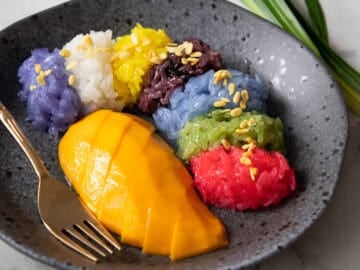
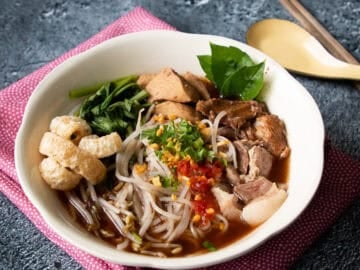
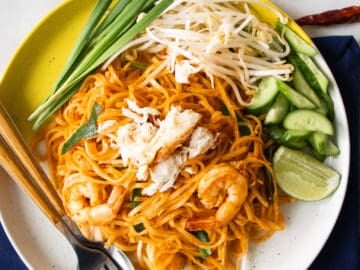
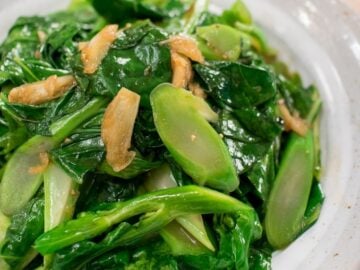


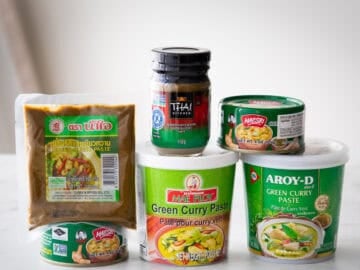

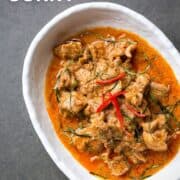
Brit says
Super good and super easy! My tip to others using dried makrut leaves is to soak them in hot water (I used water from my tea kettle) for at least fifteen minutes before putting them in. Sooo much more fragrant and flavourful that way. I also subbed tofu for pork and it was perfect - I just lightly pan fried it before throwing it in!
actual literal crab says
It was really delicious and very easy. I made it with tofu
Sven says
Isn‘t a needed vegetable for panaeng curry the pea eggplant?
Rebecca says
Absolutely delicious! My local supermarket actually sells panang curry paste, so I don't even have to make the "semi-homemade" paste. That makes this a quick and easy meal to prepare. Although I usually use the whole bellpepper, so I don't have to make an extra vegetable dish.
Quin says
So good!! I made it using store-bought curry paste and my boyfriend said it tastes better than any Thai restaurant he's been to.
Mike says
I really love how simple your recipes are the green curry is so great!! I just got some mae ploy Panang paste and want to make this tonight. I am curious if there is usually tamarin in Penang for some reason I thought there was but I didn’t see anything wondering what your thoughts are on that thank you.
Pailin Chongchitnant says
No tamarind in panang 🙂 And thank you!
Katja says
I have some Panang powder which I got at my last visit in Thailand ( I didn't know I needed paste). Could I use the powder and how much of it?
I just found your site and made already twice your Phad Thai recipe. It was so good, trying now your other recipes. Thank you
Barbara says
We had a potluck at work, and our Thai co-worker brought in panang curry. I had to make it myself!
With some tips from her, and this recipe, it was a major hit! My husband is a picky eater, but he loved it!
Angela Curtis says
Can dried kafir lime leaves be used in the recipe? I’ve no way of getting them fresh. Thank Pai!
Pailin Chongchitnant says
You can, but I would add more as dried leaves are not as aromatic, and maybe give it a little more time to infuse in the sauce.
CC says
Can you recommend a brand of store bought panang curry paste?
Pailin Chongchitnant says
Maeploy is good.
Rick says
This is quite possibly my favorite Thai Curry... Ok, maybe it's "one" of my favorite Thai Curries. I've made some of your other curry pastes and they are great! I first had Panang curry in Southern Thailand on the island of Koh Lanta and fell in love right then and there. It was poured over a crisp fried whole fish and along with the juliened Makrut leaves were crisp fried juliened Krachai, which was a delightful addition. My partner and I were in flavor heaven. I wondered where Panang originated in Thailand and your thoughts on the addition of the crisp Krachai. Can you enlighten me?
Pailin Chongchitnant says
The origins of panang curry is unclear as far as I know. And there is never a bad time to add crisp krachai to anything 😉
Hannah says
If we are making in advance, do you recommend freezing the curry once the dish is complete or freeze just the sauce and add the meat upon thawing? Thanks!!
Pailin Chongchitnant says
Ideally you would freeze just the sauce so the meat will not be overcooked due to reheating 🙂
Charles Pascual says
Very nice dish. My wife likes to have Panang curry when we eat out, so I decided to make this at home. I used store-bought Panang curry paste (Maesri brand). We had had nearly 1 pound of chicken, so I doubled the ingredient amounts, otherwise, followed your recipe as written. Super easy to make, comes together quickly. We both liked it and plan to make it again soon. Thank you, Pailin.
Cara Gonzalez says
Pailin is an angel for teaching us how to cook authentic and delicious Thai food at home. I bought her cookbook Sabai and have been so happy with everything I’ve tried so far. Can’t wait to make more. Beef panang was a favorite of mine and now I can make it myself in my own home which makes me so happy! Thank you Pailin!
Olivier says
I never tried it because I thought it was a complicated dish, with all the spices. In fact it is dumb easy and fast: buy the panaeng paste at the market, coconut milk and makrut leaves. And that's it.
I did not try to prepare the panaeng paste myself, I trust that vendor where I buy my various curry pastes.
Thank you.
Pailin Chongchitnant says
thank you!
Megan says
I lived in Koh Samui for 2 years and ate at every restaurant on the island. We traveled all through Thailand eating in Phuket, Bangkok, and all through the mainland. This recipe is very similar tasting to the Panang Curry we ate, just not as spicy ☺️. 🙏
Rodney Suffolk says
oh baby oh baby that panang curry paste ....just wow!! the extra nuts thickened the sauce so I was like satay. I used fresh kaffir and lime zest (summer just finished) as well as galangal and lemongrass from my garden...What a mouth sensation! Thank you
Lisa says
I made this recipe with chicken and it was amazing!! Tasted just like we remember from Thailand 😋
Nunoub says
I made this using Mae Ploy Panang curry sauce. I only used about 2-3 tablespoons. I could not find Kafir leaves. I also added in some sliced bell pepper and green beans. It turned out wonderfully. Thank you.
Brendon says
Delish!
Nocke Chiangmai says
Paneng originates from Penang in Malaysia, hence the name
Rachael says
I made this once with the homemade curry paste from this website and we totally loved it!
I made it again with a store bought paste and we were disappointed that we couldn't add more of the paste (i.e. more flavour) without also adding more heat. Since I still had some of the paste left I ended up making another round with a bit of the store bought paste together with the homemade panang curry paste here on HTK but made without the dried chillis! I just threw the curry paste ingredients (minus the chillis) in a magic bullet blender with some coconut milk, so it was easy easy. We enjoyed that MUCH better than the version with only the store bought paste.
Pey-Lih says
I made this recipe using kabocha squash with Chinese spinach, thinly sliced carrots, baby corn, and sugar peas. The kaffir lime made it more fragrant. Wonderful over jasmine rice or even buckwheat noodles. The starch from the squash thickened up the curry nicely. Thank you for this recipe!
Michael says
Panang curry(gai) has a fresh lemon taste.
I make it with chicken(gai)
Even when cooking it smells wonderful!
A bit spicy but yummy.
Dan says
Made it with Lobo brand panang curry paste and pork tenderloin. Excellent. Pleased to find that the pork, despite being lean, came out nice and tender. I only found frozen kaffir lime leaves, but they definitely added a nice flavor.